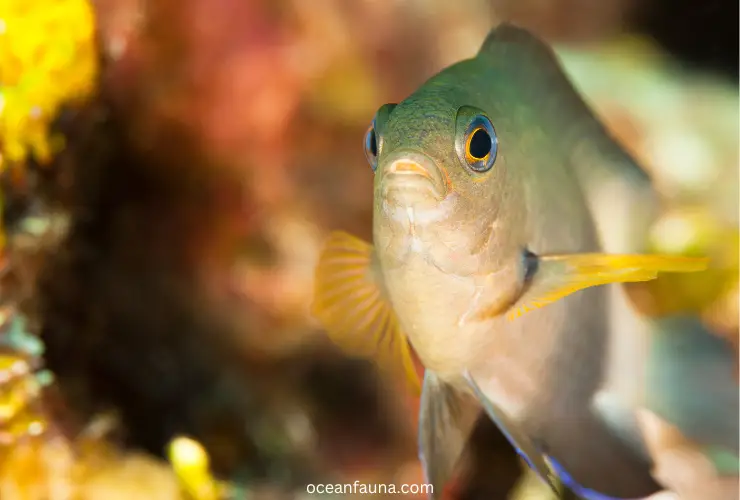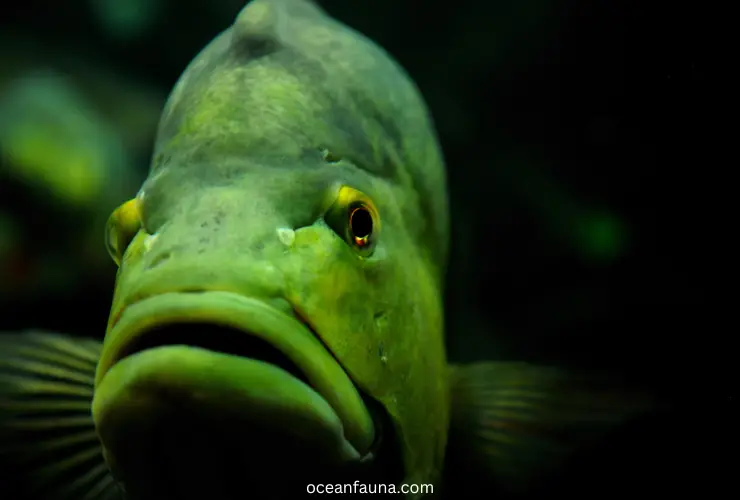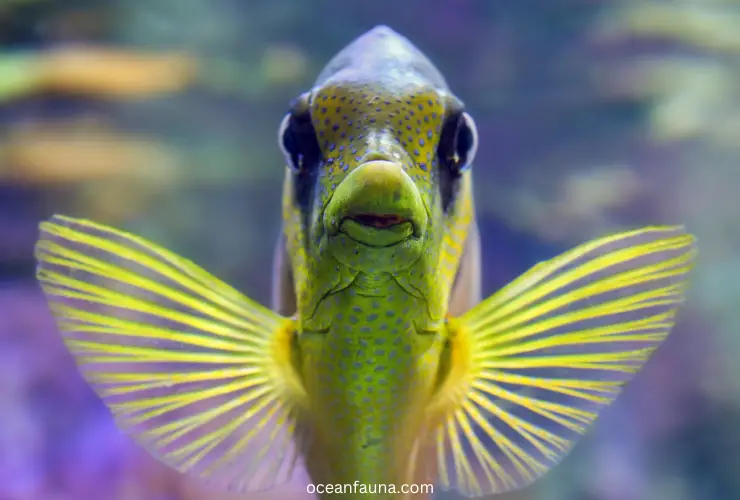In short, just as humans can’t see air, fish can’t see water. The main reason is that fish eyes have evolved to focus on objects in the water, not the water itself. The clarity of the water affects how far a fish can see, but generally speaking, its visibility range is fairly short.
Read this article to learn more about the underwater visibility of fish’s eyes.
Anatomy of Fish Eyes
The anatomy of fish eyes is a fascinating subject. Fish eyes have a unique structure and function that enable them to see and navigate through water. The following headings will provide a detailed overview of the anatomy of fish eyes.
Structure of fish eyes
Fish eyes are spherical, with a lens at the front and a retina at the back. The lens focuses light onto the retina, which contains specialized cells called photoreceptors. These photoreceptors send signals to the brain via the optic nerve, enabling the fish to see.
Types of fish eyes
There are two common types of fish eyes – round and prolate. Round eyes are found in bony fish, while prolate eyes are found in sharks and rays. Prolate eyes are more elongated and enable these fish to have a wider visual field, which is useful for detecting prey and predators.
Adaptations for underwater vision
Fish eyes are adapted to the underwater environment in several ways. The lens of the eye has a high refractive index, which means it can bend light more than air. This enables fish to see in the dim, murky light of the water.
Additionally, some fish have a reflective layer called the tapetum lucidum behind the retina, which enhances their vision in low-light conditions.
Color vision in fish
While many fish have excellent color vision, some species can only perceive certain colors. For example, some deep-sea fish can only see blue light, while some coral reef fish have a specialized eye structure that lets them see UV light.
Eye movements in fish
Fish eyes are immobile, which means they cannot move their eyes in their sockets as humans can. Instead, fish use a combination of body movements and eye rotations to track their prey or navigate through their environment.

How Do Fish See?
Fish see with their eyes, which are specifically designed for underwater vision. Unlike humans, they don’t need to wear goggles because their eyes are adapted to work in an aquatic environment.
Also See: Can Seahorses See and Hear?
The cornea, iris, and pupil of a fish’s eye are similar to ours, but their retina contains rod and cone cells that enable them to see in dim and bright light conditions.
Rod cells are responsible for scotopic vision, which is essential for navigating in low-light conditions or at night. Cone cells allow for photopic vision, which helps fish perceive colors and details in well-lit areas.
Most fish species have color vision, although the exact range of colors they can see varies. Some fish can even see ultraviolet, which is invisible to humans.
In addition to color and light, some fish are also sensitive to polarized light. This means they can detect the angle of the sun’s rays as they reflect off of surfaces, which helps them navigate and locate prey. The ability to see polarized light varies among different species of fish.
Can Fish See Water? [Explanation]
No, fish cannot see water, just as humans cannot see air. This is because water has a slightly higher refractive index than air, but it is still lower than that glass. This means the light is bent less as it passes through water than through air or glass, making the water nearly invisible to fish.

However, fish do not need to see the water surrounding them as their brains can filter out what is unnecessary. This allows fish to focus on the objects that are essential for their survival, such as prey or predators, and make quick decisions based on what they see.
The specialized cells in a fish’s retina also play a role in their vision, as they can detect the slight movements and changes in light that occur underwater. While fish do not see water visually, their unique adaptations allow them to function effectively underwater.
How Far Can Fish See Underwater?
Fish are known for their remarkable vision, which allows them to navigate and survive underwater. However, their visual range is limited, and they rely on other senses to detect distant objects.
According to scientific studies, fish can see clearly underwater up to a distance of one meter. Anything beyond that range appears blurry, and fish may fail to detect moving objects or potential threats. This limited range of vision is due to the refraction of light in water, which causes visual distortions and reduces visual acuity.
Moreover, fish have blind spots in their visual field, which vary depending on their eye configuration and body shape. Some fish have monocular vision, which means they can only see with one eye at a time, while others have binocular vision, allowing them to see simultaneously with both eyes.
However, binocular vision also creates a blind spot in the center of their visual field, where the two fields of view overlap.
Also Read: 20 Fish With Big Lips: Detail Explanation With Image
Despite the limitations of their visual range, fish have adapted strategies to compensate for their visual impairments. Some fish use their lateral line system, a series of sensory organs that run along their sides, to detect vibrations and movements in the water. This system allows fish to sense the location of nearby objects, even in complete darkness.
Can Fish See Out of Water?
Yes, but their vision is severely compromised due to the difference in refractive index between the air and their cornea. When a fish is out of the water, the cornea of its eye has to focus power, which allows them to see things clearly underwater.

However, when the fish is removed from the water, the refractive index changes, leading to a distorted image on the retina and making the fish extremely nearsighted.
In terms of their ability to see beyond the surface of the water, a fish placed in a water tank can see outside through the glass. This is because the glass of the tank has a similar refractive index to that of water, allowing for clear and undistorted vision.
In fact, this is the exact reason why we can see clearly into the water from the outside of the tank.
However, not all fish have the same visual capabilities. Some species have excellent vision in both air and water, allowing them to adapt to different environments and spot predators and prey from far distances.
Other species, such as those living in murky waters, have adapted to their environment, relying on senses like smell and taste.

Can Fish See Humans?
Yes, it has been scientifically proven that fish can see humans. In fact, some species of tropical fish, such as archerfish, have demonstrated the ability to recognize and distinguish between human faces.
This groundbreaking discovery was made through a series of experiments where the fish were trained to spit water at a specific human face they were shown. The fish were able to accurately identify and spit at the correct face, demonstrating their capability to see and remember human features.
Furthermore, research has shown that fish have eyesight adapted to their underwater environment, allowing them to perceive and process visual information differently than humans.
Also See: 20+ Fish That Change Gender [Amazing Facts]
Fish eyes are optimized for underwater vision, with a larger pupil for better light gathering and a curved lens that allows for better focus and magnification.
In addition, the colors and patterns perceived by fish can differ from those perceived by humans due to differences in the way light is absorbed and refracted in water.
The ability of fish to see humans has important implications for their behavior in captive environments. Studies have shown that fish can become stressed and agitated when humans are present, indicating that they are able to recognize and respond to our presence.
This highlights the importance of providing appropriate environmental enrichment and minimizing human disturbance to promote captive fish’s welfare.
FAQs
Can fish see air?
No, fish cannot see air due to the differences in refractive index between air and their cornea. The cornea of a fish’s eye is designed for underwater vision, making them extremely nearsighted when removed from the water.
Can fish see color?
Yes, most fish are capable of seeing and perceiving color. However, due to the way light is absorbed and refracted in water, the colors perceived by fish can differ from those seen by humans. Some species may be able to detect a wider range of colors than others, depending on their environment and needs.
Can fish see in the dark?
Yes, certain fish can see in low light conditions and even in complete darkness. They possess unique adaptations, including a larger pupil and a reflective layer behind the retina, which help them gather more light. Deep-sea fish have further adaptations that help them see in total darkness.
Can fish see through glass?
Yes, fish can see through glass if the tank has a refractive index similar to water. This results in clear and undistorted vision without creating a distorted image on their retina. This is also the reason why we can easily see the tank from outside. Furthermore, colors and patterns perceived by fish might differ from what we, humans, see.
Conclusion
Hopefully, you have a detailed idea of the fish’s vision underwater. They can’t see and describe water since the refractive index of water doesn’t match up with their eyes.
Moreover, fish eyes adapted to an underwater environment with larger pupils and curved lenses, which allows them to spot predators and prey from far distances. Let me know if you have any further queries in the comment section below.


3 thoughts on “Can Fish See Water? [No, But Why?]”